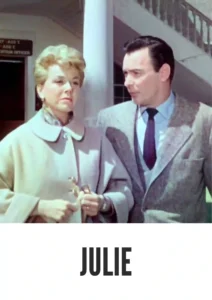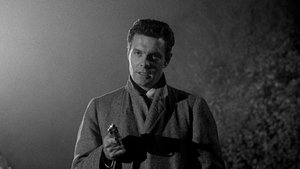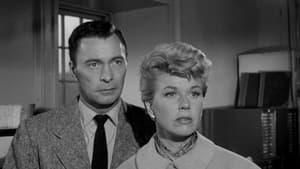Contact: info@alwanfilm.com
Video Sources 0 Views
- Watch trailer
- Julie


Synopsis
Table of Contents
ToggleJulie 1956 Colorized: A Colorful Review of an Old Classic

Introduction
Julie 1956, a seminal work directed and written by Andrew L. Stone, stands as a testament to the allure of early colored cinema. Starring the luminous Doris Day, the suave Louis Jourdan, and the compelling Barry Sullivan, this film is a masterclass in suspense and psychological drama. In this review, we explore the impact of colorization on the timeless tale of a terrified wife’s desperate attempt to escape her insanely jealous husband, who is hell-bent on killing her.
Check The Full Colorized Movies List
Check Our Colorized Movies Trailer Channel
Understanding Julie 1956 Colorized: Director, Cast, and Genre
Director Andrew L. Stone’s vision for Julie 1956 shines through in every frame, as he expertly weaves a narrative of tension and intrigue. Doris Day delivers a powerhouse performance as the beleaguered Julie, with Louis Jourdan portraying her menacing husband with chilling precision. Set within the realm of psychological thriller, Julie 1956 captivates audiences with its gripping storyline and unforgettable characters.
Exploring the World of Julie 1956 Colorized: Plot and Characters
Julie 1956 thrusts viewers into a world of palpable fear and uncertainty, as Julie finds herself trapped in a nightmarish situation. Fleeing from her husband’s homicidal intentions, she must navigate a labyrinth of deception and danger to secure her freedom. Along the way, she encounters a cast of characters whose motives are shrouded in mystery, adding layers of complexity to an already tense narrative.
The Art of Film Colorization
Colorization adds a new dimension to the viewing experience of Julie 1956, enhancing the film’s visual impact while preserving its timeless charm. Through meticulous attention to detail, the vibrant hues breathe life into each scene, transporting audiences to a bygone era with stunning clarity.
Early Colored Films: A Brief History
The emergence of early colored techniques revolutionized the film industry, allowing filmmakers to explore new realms of creativity and expression. From hand-painted frames to groundbreaking Technicolor processes, the evolution of colorization has left an indelible mark on the cinematic landscape.
Julie 1956 and Its Early Colored Version
The decision to release Julie 1956 in a colorized format was a bold one, yet it pays off handsomely in enhancing the film’s visual appeal. The vibrant colors serve to accentuate the tension and emotion of each scene, drawing viewers deeper into Julie’s harrowing plight.
The Debate Over Film Colorization
While some purists may decry the practice of colorization as sacrilege, there is no denying its ability to breathe new life into old classics. By updating Julie 1956 for modern audiences, colorization ensures that its message remains relevant and impactful for generations to come.
Examining Julie 1956 as an Early Colored Film
Colorization enhances the viewing experience of Julie 1956, imbuing each frame with a sense of vibrancy and vitality. From the lush landscapes to the intricately designed sets, the colors serve to underscore the film’s themes of fear, betrayal, and ultimately, redemption.
Influence and Legacy: Julie 1956 Colorized’s Impact on Cinema
Julie 1956’s enduring legacy is a testament to its timeless appeal and universal themes. From its groundbreaking narrative structure to its unforgettable performances, the film continues to inspire audiences and filmmakers alike, cementing its status as a true classic of the genre.
Director’s Cinematic Legacy: Beyond Julie 1956 Colorized
Director Andrew L. Stone’s contributions to the world of cinema extend far beyond Julie 1956, with a body of work that spans multiple genres and decades. His unique vision and storytelling prowess have left an indelible mark on the industry, influencing countless filmmakers and shaping the course of cinematic history.
Themes Explored in Julie 1956
At its core, Julie 1956 delves into themes of fear, betrayal, and the resilience of the human spirit. Through Julie’s harrowing journey, the film offers a poignant commentary on the power of love and the lengths one will go to in order to survive.
Reception and Controversy Surrounding Julie 1956 Colorized
Upon its release, Julie 1956 garnered critical acclaim for its gripping storyline and stellar performances. While some may debate the merits of colorization, there is no denying the film’s impact on audiences and its enduring place in cinematic history.
FAQs About Julie 1956 Colorized
Frequently Asked Questions (FAQs) about Julie 1956 provide valuable insights into various aspects of the film, from its production history to its cultural impact:
1. What is the plot of Julie 1956?
Julie 1956 follows the story of a terrified wife who attempts to escape from her insanely jealous husband, who is determined to kill her. As she navigates a perilous journey to freedom, Julie must confront her deepest fears and summon the courage to fight for her life.
2. Who are the main actors in Julie 1956?
The main actors in Julie 1956 include Doris Day, Louis Jourdan, and Barry Sullivan. Doris Day delivers a captivating performance as the titular character, while Louis Jourdan and Barry Sullivan portray her husband and a pivotal supporting character, respectively, with remarkable skill and intensity.
3. What is the significance of colorization in Julie 1956?
Colorization adds a new layer of visual richness to Julie 1956, enhancing the film’s aesthetic appeal while preserving its timeless charm. By infusing each frame with vibrant hues and tones, colorization breathes new life into the classic tale, captivating audiences with its stunning visual imagery.
4. How does Julie 1956 compare to other films of its genre?
Julie 1956 stands out among other films of its genre due to its gripping storyline, nuanced characters, and exceptional performances. Director Andrew L. Stone’s masterful direction and the film’s innovative use of colorization set it apart as a true cinematic gem, deserving of its status as a classic of the psychological thriller genre.
5. Where can I watch Julie 1956 online?
Julie 1956 is available for streaming on various platforms, allowing audiences to experience the timeless tale of love and survival from the comfort of their own homes. Whether you prefer to watch it in its original black and white format or the vibrant hues of colorization, Julie 1956 promises an unforgettable cinematic journey.
Conclusion
In conclusion, Julie 1956 remains a timeless classic that continues to captivate audiences with its gripping storyline, stellar performances, and innovative use of colorization. From its haunting themes to its unforgettable characters, the film stands as a testament to the enduring power of cinema to entertain, inspire, and provoke thought. Whether viewed in its original black and white format or in the vibrant hues of colorization, Julie 1956 remains a must-see for cinephiles of all generations, offering a timeless reminder of the artistry and innovation that define the golden age of Hollywood.















